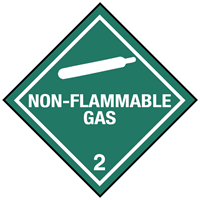
 Print
Print
Chemical Datasheet
CARBON DIOXIDE AND NITROUS OXIDE MIXTURE |

|
Chemical Identifiers
| CAS Number |
UN/NA Number |
DOT Hazard Label |
USCG CHRIS Code |
- 124-38-9

- 10024-97-2

|
|
|
none
|
| NIOSH Pocket Guide |
International Chem Safety Card |
|
Carbon dioxide
|
- CARBON DIOXIDE
- NITROUS OXIDE
|
NFPA 704
data unavailable
General Description
A colorless sweet tasting mixture of gases. Both components are noncombustible. Can asphyxiate by the displacement of air. Under prolonged exposure to fire or intense heat the containers may rupture violently and rocket.
Hazards
Reactivity Alerts
none
Air & Water Reactions
Carbon dioxide is water soluble, and forms carbonic acid, a mild acid in water.
Fire Hazard
No information available.
Health Hazard
No information available.
Reactivity Profile
NITROUS OXIDE is an oxidizing agent. Nonflammable but supports combustion. Can explode at high temperature (after vaporization). Vapors can undergo a violent reaction with aluminum, boron, hydrazine, lithium hydride, phenyllithium, phosphine, sodium, tungsten carbide [Bretherick, 5th ed., 1995, p. 1686].
Dusts of magnesium, lithium, potassium, sodium, zirconium, titanium, and some magnesium-aluminum alloys, and heated aluminum, chromium, and magnesium when suspended in CARBON DIOXIDE are ignitable and explosive. This is especially true in the presence of strong oxidizers, such as peroxides. The presence of carbon dioxide in solutions of aluminum hydride in ether can cause violent decomposition on warming the residue, [J. Amer. Chem. Soc., 1948, 70, 877]. Dangers arising from the use of carbon dioxide in the fire prevention and extinguishing systems of confined volumes of air and flammable vapors are examined. The hazard associated with its use centers around the fact that large electrostatic discharges may be created that initiate explosion, [Quart. Saf. Summ., 1973, 44(1740, 10].
Belongs to the Following Reactive Group(s)
Potentially Incompatible Absorbents
No information available.
Response Recommendations
Isolation and Evacuation
No information available.
Firefighting
No information available.
Non-Fire Response
No information available.
Protective Clothing
No information available.
DuPont Tychem® Suit Fabrics
Normalized Breakthrough Times (in Minutes)
| Chemical |
CAS Number |
State |
QS |
QC |
SL |
C3 |
TF |
TP |
RC |
TK |
RF |
| Nitrous oxide |
10024-97-2 |
Vapor |
|
|
|
|
|
|
>480 |
>480 |
>480 |
Special Warning from DuPont: Tychem® and Tyvek® fabrics should not be
used around heat, flames, sparks or in potentially flammable or
explosive environments. Only...
(DuPont, 2024)
First Aid
No information available.
Physical Properties
| Chemical Formula: |
- CO2 (carbon dioxide)
- N2O (nitrous oxide)
|
Flash Point: data unavailable
Lower Explosive Limit (LEL): data unavailable
Upper Explosive Limit (UEL): data unavailable
Autoignition Temperature: data unavailable
Melting Point: data unavailable
Vapor Pressure: data unavailable
Vapor Density (Relative to Air): data unavailable
Specific Gravity: data unavailable
Boiling Point: data unavailable
Molecular Weight: data unavailable
Water Solubility: data unavailable
Ionization Energy/Potential:
13.77 eV
[From NPG: Carbon dioxide]
(NIOSH, 2024)
IDLH:
40000 ppm
[From NPG: Carbon dioxide]
(NIOSH, 2024)
AEGLs (Acute Exposure Guideline Levels)
No AEGL information available.
ERPGs (Emergency Response Planning Guidelines)
No ERPG information available.
PACs (Protective Action Criteria)
| Chemical |
PAC-1 |
PAC-2 |
PAC-3 |
| Carbon dioxide (124-38-9)
|
54000 mg/m3 |
72000 mg/m3 |
90000 mg/m3 |
| Nitrous oxide (10024-97-2)
|
910 ppm |
10000 ppm |
20000 ppm |
(DOE, 2024)
Regulatory Information
EPA Consolidated List of Lists
No regulatory information available.
CISA Chemical Facility Anti-Terrorism Standards (CFATS)
No regulatory information available.
OSHA Process Safety Management (PSM) Standard List
No regulatory information available.
Alternate Chemical Names
- CARBON DIOXIDE AND NITROUS OXIDE MIXTURE
- CARBON DIOXIDE-NITROGEN OXIDE (N2O) MIXTURE
- CARBON DIOXIDE-NITROUS OXIDE MIXT.
- CARBON DIOXIDE-NITROUS OXIDE MIXTURE
- NITROGEN OXIDE (N2O), MIXT. CONTAINING
- NITROUS OXIDE AND CARBON DIOXIDE MIXTURE


 Print
Print
